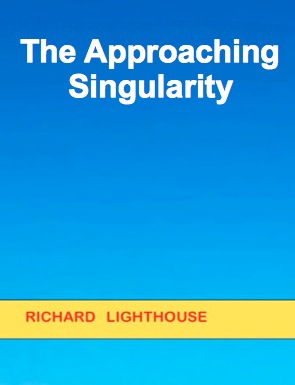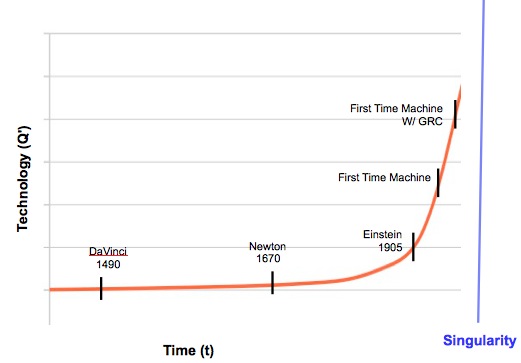32. The Approaching Singularity

Richard Lighthouse
Creative Commons 4.0 International License; 2020 by Richard Lighthouse.
CC BY 4.0
Please acknowledge source. RLighthouse.com

ISBN: 9781310635977
16 October 2014 - original
Revision 1c – 16 October 2014
Houston, Texas, U.S.A.
WARNING: The NSA has likely placed electronic tracking tags in this document. Please consider printing for distribution.
The Approaching Singularity
Abstract
This short paper presents a concept involving time and technology, that will seem to make “time stand still.” It involves the nature of technology and how it affects our lives. If we define Q' as a non-dimensional measure of the quality and quantity of technology in our lives, in general, it can be said that Q' has increased over time. But more than that, the rate of Q' has increased over time, becoming dramatically faster recently. Recall that in Alvin Toffler's, Future Shock, as a individual, we become overwhelmed by the technological advances. This paper proposes a limit in time, where technology becomes so advanced that time is not only an illusion, but meaningless.
1. Introduction
We will define Q' as a non-dimensional measure of the quality and quantity of technology in our lives. Q' is increasing and so is its rate. We are rapidly approaching a limit; a singularity limit.
There are a number of events that are leading us to this singularity. Once the implications are understood, time will seem to “stand still” for all of those involved.
In Figure 1, we can deduce that technology has proceeded at an increasing rate, and as the rate increases, it results in more and better technology. The “system” is “resonant.”

Figure 1.
In general, we can state that technology is tied to mathematical understanding, i.e., applied physics and engineering. Event 4 in the chart, marks the first operational time machine. This is critical because the rate of Q' increases even faster by retrieving future technology, and returning it to the present moment. This will be quickly followed by improving designs that take advantage of Massless Travel. [5]
Optical timing clocks (10^15) will be the first logical development, followed by X-ray timing clocks (10^17), and then Gamma-Ray Clocks (GRC) at about (10^20+).
This is significant because with Gamma-Ray clocks (GRC) it gives the passenger easy access to millions of years in the past or future, in our terms. Any technology that will ever be developed becomes available in the present moment.
Basically, we become able to live our lives:
As long as we choose,
In any time period,
In any location
...so that time becomes meaningless. In essence, time stands still.
This approaching singularity is almost certain to occur, probably within our current lifetime. [Which explains why the Tau 9 meetings were arranged.] [6] The common theme of the Tau 9 meetings seem to be - your people must learn to work together, or they will perish together.
2. Further Research
By my estimation, at least 12 countries are aggressively pursuing a prototype time machine design, right now. You will not read about it in the news. It is too important, and they are likely avoiding the eyes and ears of the intelligence services. The genie is out of the bottle.
3. Conclusions
Ray Kurzweil sees the singularity occurring due to a merger of man-machine systems, artificial intelligence, and nanotechnology. [2] There is, however, one primary reason these later technologies are developed: The operation of the first time machine, which rapidly accelerates the process.
1. This paper has presented a concept involving a singularity limit in time.
2. Many Time Machines will be operating soon.
3. The process of traveling forward in time and retrieving technology can be described as a resonant feedback system, which accelerates rapidly.
4. The genie is out of the bottle and the magic is beginning...
This is a living document. The author reserves the right to make corrections and changes.
10. References
1. Alvin Toffler, Future Shock, Bantam Books; 1970.
2. Ray Kurzweil, The Singularity is Near, 2005.
3. Richard Lighthouse, Time Travel: An Approximate Mathematical Solution, Smashwords.com; 2013. https://www.smashwords.com/books/view/376189
4. Richard Lighthouse, Prototype Design for a Time Machine, Smashwords.com; 2013. https://www.smashwords.com/books/view/376192
5. Richard Lighthouse, Massless Travel, smashwords.com; 2014.
https://www.smashwords.com/books/view/403365
6. Richard Lighthouse, Recommendations for Tau 9 Treaty Negotiations, Smashwords.com; 2013. https://www.smashwords.com/books/view/392428
7. John Titor's Time Machine, GE c204, www.scribd.com/mobile/doc/36979450





